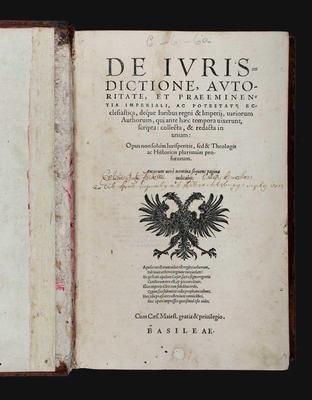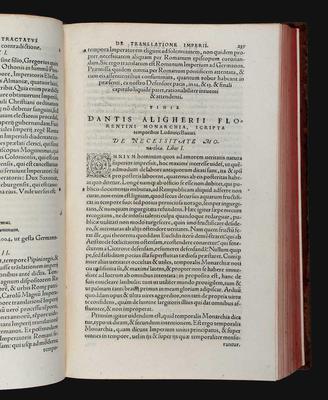Dante Alighieri
Dantis Aligherii Florentini Monarchia, scripta temporibus Ludovici Bavari, in: De iurisdictione, autoritate, et praeminentia imperiali, ac potestate, ecclesiastica, déque Iuribus regni & Imperii, variorum Authorum.
Basel, Johann Oporinus, 15 March 1566.Folio (295 × 189 mm). Collation: α6, β4, a-z6, A-Z6, Aa-Zz6, aa-bb6, cc4, dd-ii6, kk4. 18, [2], 914, [20] pp. With the imperial eagle on the title-page. Seventeenth-century marbled calf, red edges (spine and panels heavily worn). A good copy. Small hole repaired on the title-page, some wormholes in the blank margin of the first and last leaves, some quires slightly browned.
Provenance:Franciscus Ignatius Albrecht ab Albrechtsburg (seventeenth-century ownership inscription);Giulio Federico Buccelleni of Reichenberg, who between 1701 and 1703 was councellor of Austria (ownership inscription on the title-page); Livio Ambrogiocollection.
Second edition of De Monarchia, here published in a collection of political texts, edited by the Protestant scholar Simon Schard, which includes such authors as Jean de Paris, Marsilio da Padova, Landolfo Colonna, Jordan von Osnabrück, Pius II, Leopold von Bebenburg, Nicolaus Cusanus, Francesco Zabarella, Walram, Michale Köchlin (Coccineus), Lorenzo Valla, Theoderich von Nieheim, and Schard himself.Dante's treatise (fols. u5r-A4v), written in Latin and divided into three books, deals with the long-debated issue of the relationship between the secular power of the Empire and the spiritual power of the Church. Dante shows no hesitation in supporting the secular power against any interference of the Church and states the equal importance of the two authorities, which in his view derive both their legitimacy from God and are both necessary for achieving human happiness. For this assumptions, the work was publicly burned by the French bishop and cardinal Bertrand du Pouget in 1329 and was put in the first Roman Index of prohibited books in 1559.Around twenty manuscripts of the ‘Monarchy', written at an unknown time in the years of Dante's exile, are known today, from the fourteenthand fifteenthcenturies. The first edition was printed by Johann Herbst (Johannes Oporinus) at Basel in 1559 in a collection of political writings (Andreae Alciati [...] De formula Romani imperij libellus. Accesserunt non dissimilis argumenti, Dantis Florentini Monarchia libri tres. Radulphi Carnotensis De translatione imperij libellus. Chronica M. Iordanis, qualiter Romanum imperium translatum sit ad Germanos). This second edition was reissued in 1609. Due to the hostility of the Church, the first official Italian edition was printed only in 1758 by Antonio Zatta as part of Dante's collected works. Previously the Venetian printer Giovanni Battista Pasquali had clandestinely issued the text with fake printing data.



